Comprehensive Report on UK Law: Classification, Sources, and Torts
VerifiedAdded on 2023/06/18
|8
|2515
|428
Report
AI Summary
This report provides an overview of the UK legal system, covering the classification of law into criminal and civil categories, the sources of law including case law, legislation, and delegated legislation, and an examination of tort law, specifically focusing on duty of care, causation, and vicarious liability. It details the roles of various courts, such as the High Court and Supreme Court, in the legal process. The report explains the law-making process in the UK, highlighting the roles of the House of Commons and House of Lords. It concludes that law is a crucial element for maintaining order and security, with legislation and common law serving as the primary mechanisms for legal governance. The report emphasizes the importance of understanding these legal concepts for individuals and organizations operating within the UK.

top15529 bmp4002
Paraphrase This Document
Need a fresh take? Get an instant paraphrase of this document with our AI Paraphraser
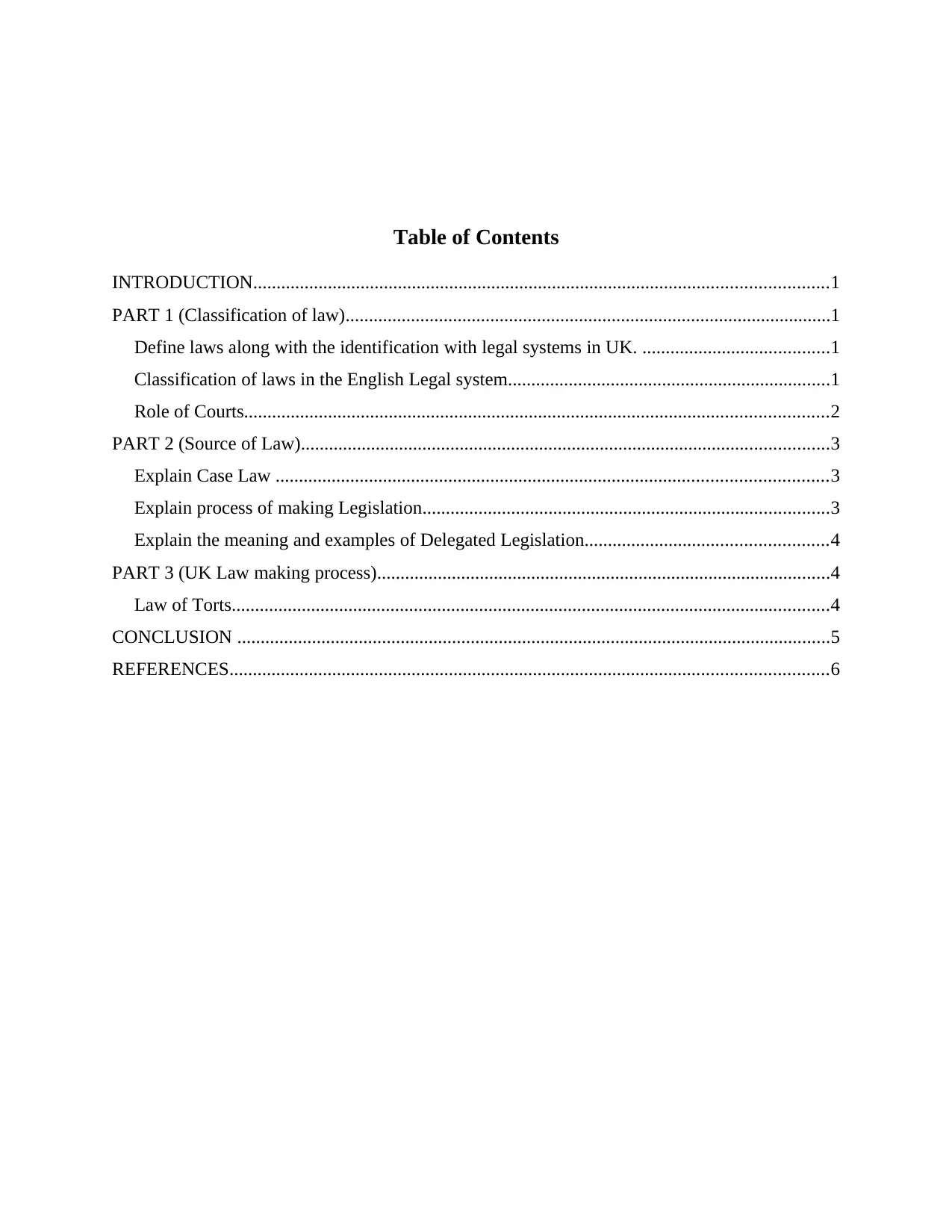
Table of Contents
INTRODUCTION...........................................................................................................................1
PART 1 (Classification of law)........................................................................................................1
Define laws along with the identification with legal systems in UK. ........................................1
Classification of laws in the English Legal system.....................................................................1
Role of Courts.............................................................................................................................2
PART 2 (Source of Law).................................................................................................................3
Explain Case Law ......................................................................................................................3
Explain process of making Legislation.......................................................................................3
Explain the meaning and examples of Delegated Legislation....................................................4
PART 3 (UK Law making process).................................................................................................4
Law of Torts................................................................................................................................4
CONCLUSION ...............................................................................................................................5
REFERENCES................................................................................................................................6
INTRODUCTION...........................................................................................................................1
PART 1 (Classification of law)........................................................................................................1
Define laws along with the identification with legal systems in UK. ........................................1
Classification of laws in the English Legal system.....................................................................1
Role of Courts.............................................................................................................................2
PART 2 (Source of Law).................................................................................................................3
Explain Case Law ......................................................................................................................3
Explain process of making Legislation.......................................................................................3
Explain the meaning and examples of Delegated Legislation....................................................4
PART 3 (UK Law making process).................................................................................................4
Law of Torts................................................................................................................................4
CONCLUSION ...............................................................................................................................5
REFERENCES................................................................................................................................6
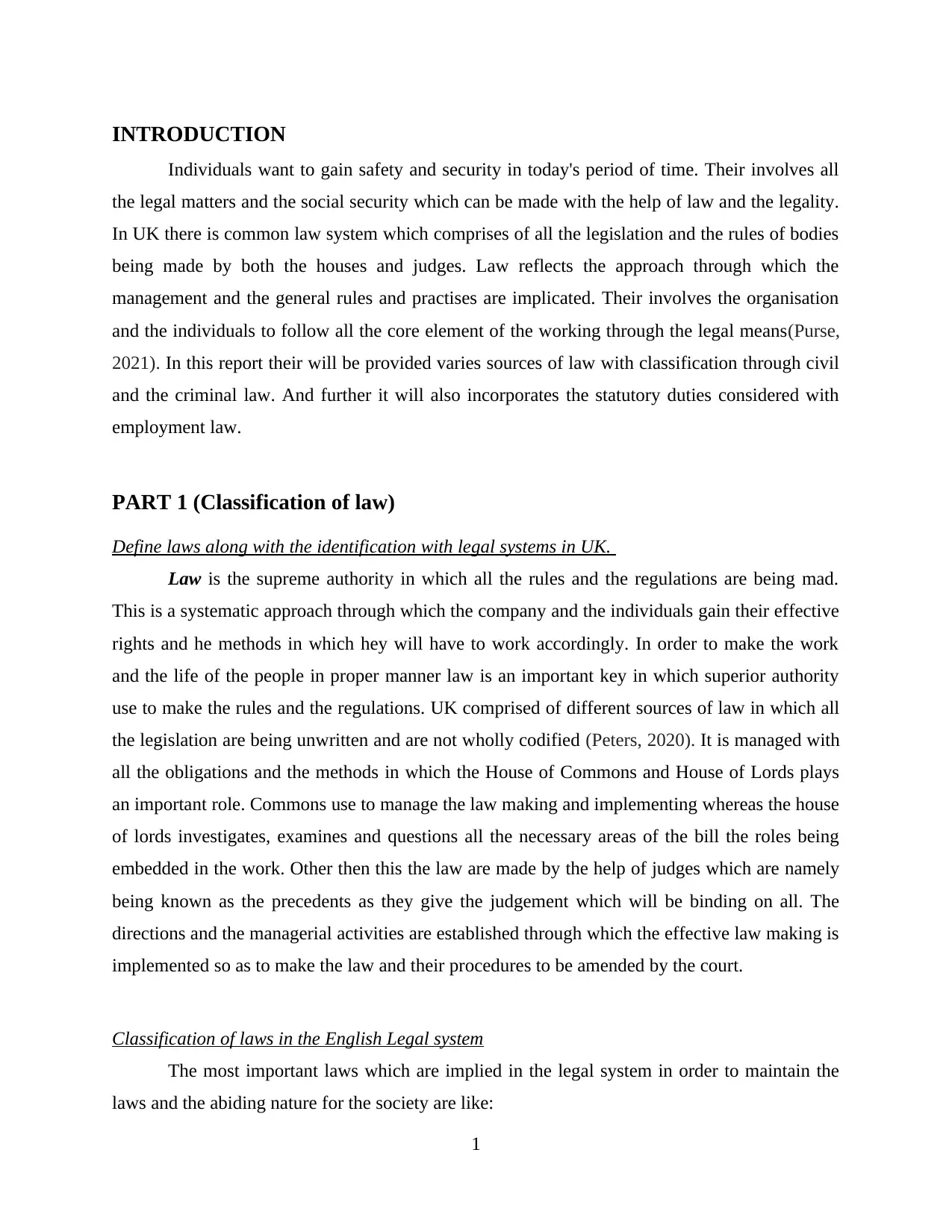
INTRODUCTION
Individuals want to gain safety and security in today's period of time. Their involves all
the legal matters and the social security which can be made with the help of law and the legality.
In UK there is common law system which comprises of all the legislation and the rules of bodies
being made by both the houses and judges. Law reflects the approach through which the
management and the general rules and practises are implicated. Their involves the organisation
and the individuals to follow all the core element of the working through the legal means(Purse,
2021). In this report their will be provided varies sources of law with classification through civil
and the criminal law. And further it will also incorporates the statutory duties considered with
employment law.
PART 1 (Classification of law)
Define laws along with the identification with legal systems in UK.
Law is the supreme authority in which all the rules and the regulations are being mad.
This is a systematic approach through which the company and the individuals gain their effective
rights and he methods in which hey will have to work accordingly. In order to make the work
and the life of the people in proper manner law is an important key in which superior authority
use to make the rules and the regulations. UK comprised of different sources of law in which all
the legislation are being unwritten and are not wholly codified (Peters, 2020). It is managed with
all the obligations and the methods in which the House of Commons and House of Lords plays
an important role. Commons use to manage the law making and implementing whereas the house
of lords investigates, examines and questions all the necessary areas of the bill the roles being
embedded in the work. Other then this the law are made by the help of judges which are namely
being known as the precedents as they give the judgement which will be binding on all. The
directions and the managerial activities are established through which the effective law making is
implemented so as to make the law and their procedures to be amended by the court.
Classification of laws in the English Legal system
The most important laws which are implied in the legal system in order to maintain the
laws and the abiding nature for the society are like:
1
Individuals want to gain safety and security in today's period of time. Their involves all
the legal matters and the social security which can be made with the help of law and the legality.
In UK there is common law system which comprises of all the legislation and the rules of bodies
being made by both the houses and judges. Law reflects the approach through which the
management and the general rules and practises are implicated. Their involves the organisation
and the individuals to follow all the core element of the working through the legal means(Purse,
2021). In this report their will be provided varies sources of law with classification through civil
and the criminal law. And further it will also incorporates the statutory duties considered with
employment law.
PART 1 (Classification of law)
Define laws along with the identification with legal systems in UK.
Law is the supreme authority in which all the rules and the regulations are being mad.
This is a systematic approach through which the company and the individuals gain their effective
rights and he methods in which hey will have to work accordingly. In order to make the work
and the life of the people in proper manner law is an important key in which superior authority
use to make the rules and the regulations. UK comprised of different sources of law in which all
the legislation are being unwritten and are not wholly codified (Peters, 2020). It is managed with
all the obligations and the methods in which the House of Commons and House of Lords plays
an important role. Commons use to manage the law making and implementing whereas the house
of lords investigates, examines and questions all the necessary areas of the bill the roles being
embedded in the work. Other then this the law are made by the help of judges which are namely
being known as the precedents as they give the judgement which will be binding on all. The
directions and the managerial activities are established through which the effective law making is
implemented so as to make the law and their procedures to be amended by the court.
Classification of laws in the English Legal system
The most important laws which are implied in the legal system in order to maintain the
laws and the abiding nature for the society are like:
1
You're viewing a preview
Unlock full access by subscribing today!
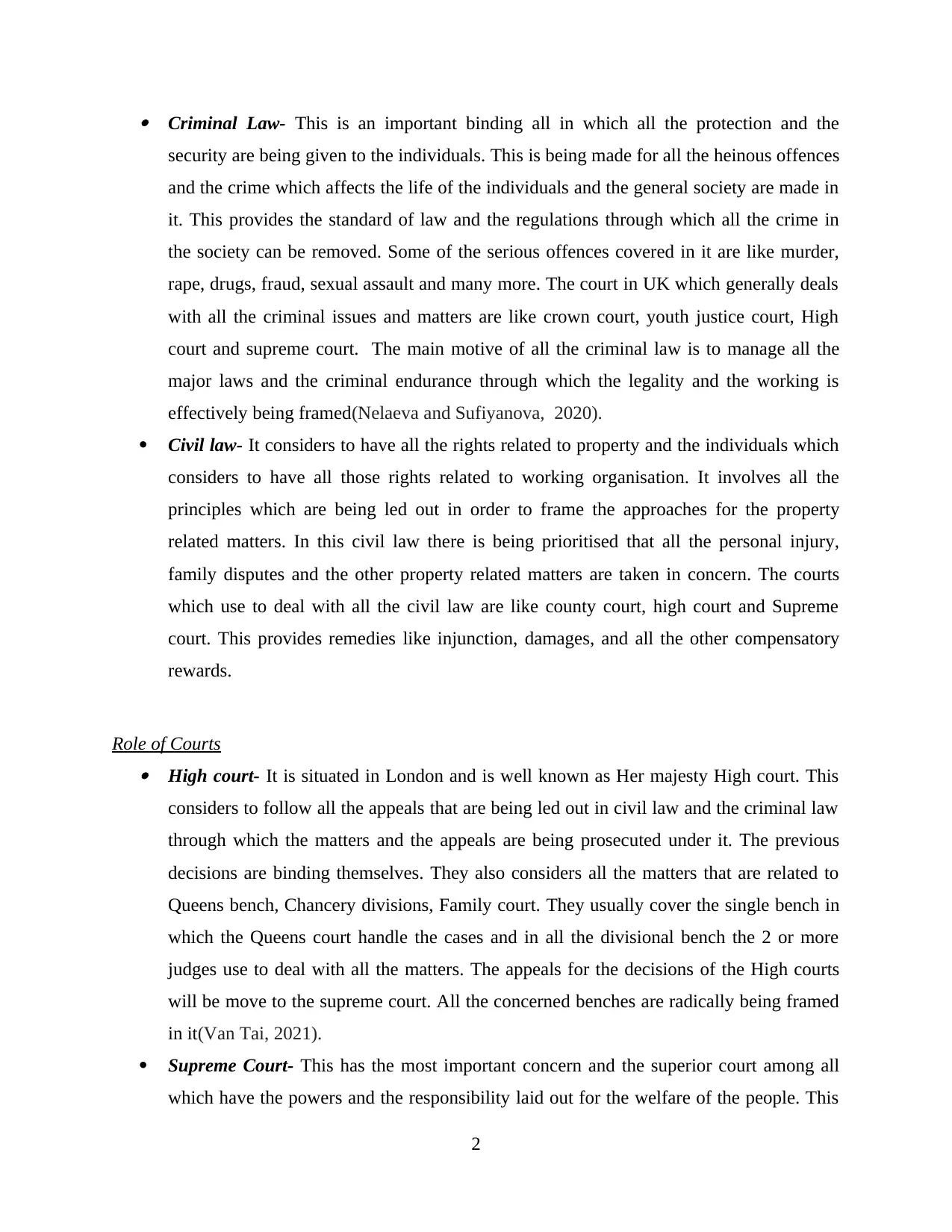
Criminal Law- This is an important binding all in which all the protection and the
security are being given to the individuals. This is being made for all the heinous offences
and the crime which affects the life of the individuals and the general society are made in
it. This provides the standard of law and the regulations through which all the crime in
the society can be removed. Some of the serious offences covered in it are like murder,
rape, drugs, fraud, sexual assault and many more. The court in UK which generally deals
with all the criminal issues and matters are like crown court, youth justice court, High
court and supreme court. The main motive of all the criminal law is to manage all the
major laws and the criminal endurance through which the legality and the working is
effectively being framed(Nelaeva and Sufiyanova, 2020).
Civil law- It considers to have all the rights related to property and the individuals which
considers to have all those rights related to working organisation. It involves all the
principles which are being led out in order to frame the approaches for the property
related matters. In this civil law there is being prioritised that all the personal injury,
family disputes and the other property related matters are taken in concern. The courts
which use to deal with all the civil law are like county court, high court and Supreme
court. This provides remedies like injunction, damages, and all the other compensatory
rewards.
Role of Courts High court- It is situated in London and is well known as Her majesty High court. This
considers to follow all the appeals that are being led out in civil law and the criminal law
through which the matters and the appeals are being prosecuted under it. The previous
decisions are binding themselves. They also considers all the matters that are related to
Queens bench, Chancery divisions, Family court. They usually cover the single bench in
which the Queens court handle the cases and in all the divisional bench the 2 or more
judges use to deal with all the matters. The appeals for the decisions of the High courts
will be move to the supreme court. All the concerned benches are radically being framed
in it(Van Tai, 2021).
Supreme Court- This has the most important concern and the superior court among all
which have the powers and the responsibility laid out for the welfare of the people. This
2
security are being given to the individuals. This is being made for all the heinous offences
and the crime which affects the life of the individuals and the general society are made in
it. This provides the standard of law and the regulations through which all the crime in
the society can be removed. Some of the serious offences covered in it are like murder,
rape, drugs, fraud, sexual assault and many more. The court in UK which generally deals
with all the criminal issues and matters are like crown court, youth justice court, High
court and supreme court. The main motive of all the criminal law is to manage all the
major laws and the criminal endurance through which the legality and the working is
effectively being framed(Nelaeva and Sufiyanova, 2020).
Civil law- It considers to have all the rights related to property and the individuals which
considers to have all those rights related to working organisation. It involves all the
principles which are being led out in order to frame the approaches for the property
related matters. In this civil law there is being prioritised that all the personal injury,
family disputes and the other property related matters are taken in concern. The courts
which use to deal with all the civil law are like county court, high court and Supreme
court. This provides remedies like injunction, damages, and all the other compensatory
rewards.
Role of Courts High court- It is situated in London and is well known as Her majesty High court. This
considers to follow all the appeals that are being led out in civil law and the criminal law
through which the matters and the appeals are being prosecuted under it. The previous
decisions are binding themselves. They also considers all the matters that are related to
Queens bench, Chancery divisions, Family court. They usually cover the single bench in
which the Queens court handle the cases and in all the divisional bench the 2 or more
judges use to deal with all the matters. The appeals for the decisions of the High courts
will be move to the supreme court. All the concerned benches are radically being framed
in it(Van Tai, 2021).
Supreme Court- This has the most important concern and the superior court among all
which have the powers and the responsibility laid out for the welfare of the people. This
2
Paraphrase This Document
Need a fresh take? Get an instant paraphrase of this document with our AI Paraphraser
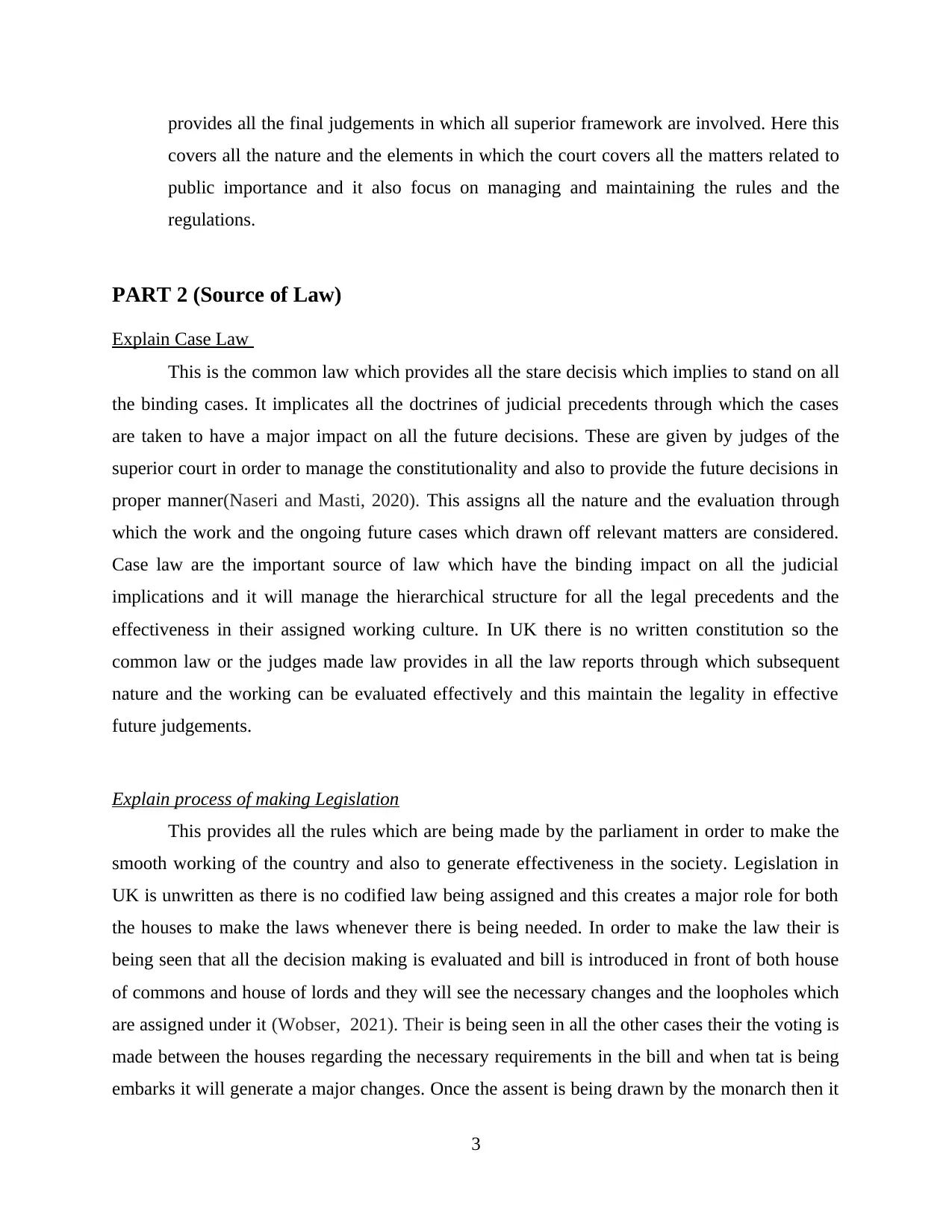
provides all the final judgements in which all superior framework are involved. Here this
covers all the nature and the elements in which the court covers all the matters related to
public importance and it also focus on managing and maintaining the rules and the
regulations.
PART 2 (Source of Law)
Explain Case Law
This is the common law which provides all the stare decisis which implies to stand on all
the binding cases. It implicates all the doctrines of judicial precedents through which the cases
are taken to have a major impact on all the future decisions. These are given by judges of the
superior court in order to manage the constitutionality and also to provide the future decisions in
proper manner(Naseri and Masti, 2020). This assigns all the nature and the evaluation through
which the work and the ongoing future cases which drawn off relevant matters are considered.
Case law are the important source of law which have the binding impact on all the judicial
implications and it will manage the hierarchical structure for all the legal precedents and the
effectiveness in their assigned working culture. In UK there is no written constitution so the
common law or the judges made law provides in all the law reports through which subsequent
nature and the working can be evaluated effectively and this maintain the legality in effective
future judgements.
Explain process of making Legislation
This provides all the rules which are being made by the parliament in order to make the
smooth working of the country and also to generate effectiveness in the society. Legislation in
UK is unwritten as there is no codified law being assigned and this creates a major role for both
the houses to make the laws whenever there is being needed. In order to make the law their is
being seen that all the decision making is evaluated and bill is introduced in front of both house
of commons and house of lords and they will see the necessary changes and the loopholes which
are assigned under it (Wobser, 2021). Their is being seen in all the other cases their the voting is
made between the houses regarding the necessary requirements in the bill and when tat is being
embarks it will generate a major changes. Once the assent is being drawn by the monarch then it
3
covers all the nature and the elements in which the court covers all the matters related to
public importance and it also focus on managing and maintaining the rules and the
regulations.
PART 2 (Source of Law)
Explain Case Law
This is the common law which provides all the stare decisis which implies to stand on all
the binding cases. It implicates all the doctrines of judicial precedents through which the cases
are taken to have a major impact on all the future decisions. These are given by judges of the
superior court in order to manage the constitutionality and also to provide the future decisions in
proper manner(Naseri and Masti, 2020). This assigns all the nature and the evaluation through
which the work and the ongoing future cases which drawn off relevant matters are considered.
Case law are the important source of law which have the binding impact on all the judicial
implications and it will manage the hierarchical structure for all the legal precedents and the
effectiveness in their assigned working culture. In UK there is no written constitution so the
common law or the judges made law provides in all the law reports through which subsequent
nature and the working can be evaluated effectively and this maintain the legality in effective
future judgements.
Explain process of making Legislation
This provides all the rules which are being made by the parliament in order to make the
smooth working of the country and also to generate effectiveness in the society. Legislation in
UK is unwritten as there is no codified law being assigned and this creates a major role for both
the houses to make the laws whenever there is being needed. In order to make the law their is
being seen that all the decision making is evaluated and bill is introduced in front of both house
of commons and house of lords and they will see the necessary changes and the loopholes which
are assigned under it (Wobser, 2021). Their is being seen in all the other cases their the voting is
made between the houses regarding the necessary requirements in the bill and when tat is being
embarks it will generate a major changes. Once the assent is being drawn by the monarch then it
3
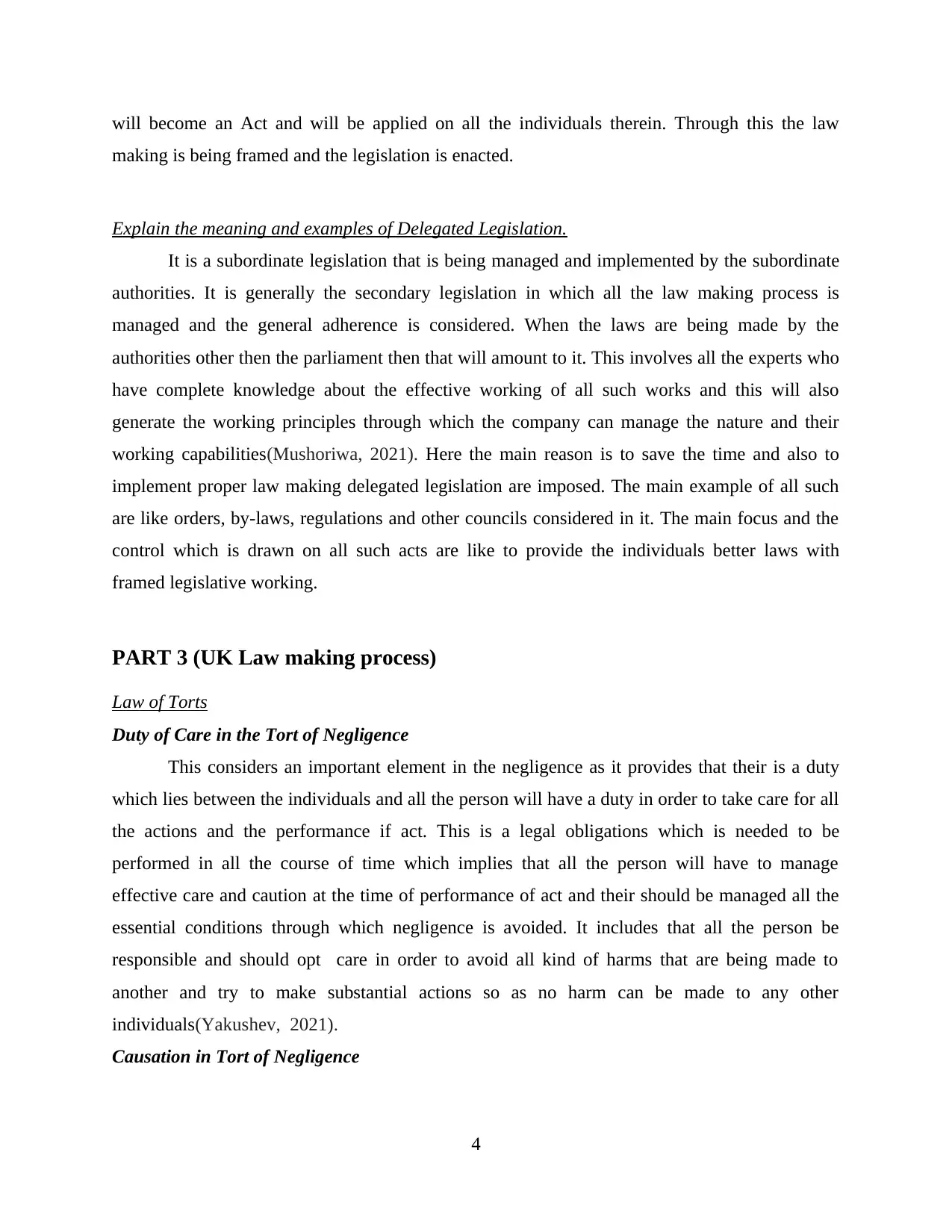
will become an Act and will be applied on all the individuals therein. Through this the law
making is being framed and the legislation is enacted.
Explain the meaning and examples of Delegated Legislation.
It is a subordinate legislation that is being managed and implemented by the subordinate
authorities. It is generally the secondary legislation in which all the law making process is
managed and the general adherence is considered. When the laws are being made by the
authorities other then the parliament then that will amount to it. This involves all the experts who
have complete knowledge about the effective working of all such works and this will also
generate the working principles through which the company can manage the nature and their
working capabilities(Mushoriwa, 2021). Here the main reason is to save the time and also to
implement proper law making delegated legislation are imposed. The main example of all such
are like orders, by-laws, regulations and other councils considered in it. The main focus and the
control which is drawn on all such acts are like to provide the individuals better laws with
framed legislative working.
PART 3 (UK Law making process)
Law of Torts
Duty of Care in the Tort of Negligence
This considers an important element in the negligence as it provides that their is a duty
which lies between the individuals and all the person will have a duty in order to take care for all
the actions and the performance if act. This is a legal obligations which is needed to be
performed in all the course of time which implies that all the person will have to manage
effective care and caution at the time of performance of act and their should be managed all the
essential conditions through which negligence is avoided. It includes that all the person be
responsible and should opt care in order to avoid all kind of harms that are being made to
another and try to make substantial actions so as no harm can be made to any other
individuals(Yakushev, 2021).
Causation in Tort of Negligence
4
making is being framed and the legislation is enacted.
Explain the meaning and examples of Delegated Legislation.
It is a subordinate legislation that is being managed and implemented by the subordinate
authorities. It is generally the secondary legislation in which all the law making process is
managed and the general adherence is considered. When the laws are being made by the
authorities other then the parliament then that will amount to it. This involves all the experts who
have complete knowledge about the effective working of all such works and this will also
generate the working principles through which the company can manage the nature and their
working capabilities(Mushoriwa, 2021). Here the main reason is to save the time and also to
implement proper law making delegated legislation are imposed. The main example of all such
are like orders, by-laws, regulations and other councils considered in it. The main focus and the
control which is drawn on all such acts are like to provide the individuals better laws with
framed legislative working.
PART 3 (UK Law making process)
Law of Torts
Duty of Care in the Tort of Negligence
This considers an important element in the negligence as it provides that their is a duty
which lies between the individuals and all the person will have a duty in order to take care for all
the actions and the performance if act. This is a legal obligations which is needed to be
performed in all the course of time which implies that all the person will have to manage
effective care and caution at the time of performance of act and their should be managed all the
essential conditions through which negligence is avoided. It includes that all the person be
responsible and should opt care in order to avoid all kind of harms that are being made to
another and try to make substantial actions so as no harm can be made to any other
individuals(Yakushev, 2021).
Causation in Tort of Negligence
4
You're viewing a preview
Unlock full access by subscribing today!
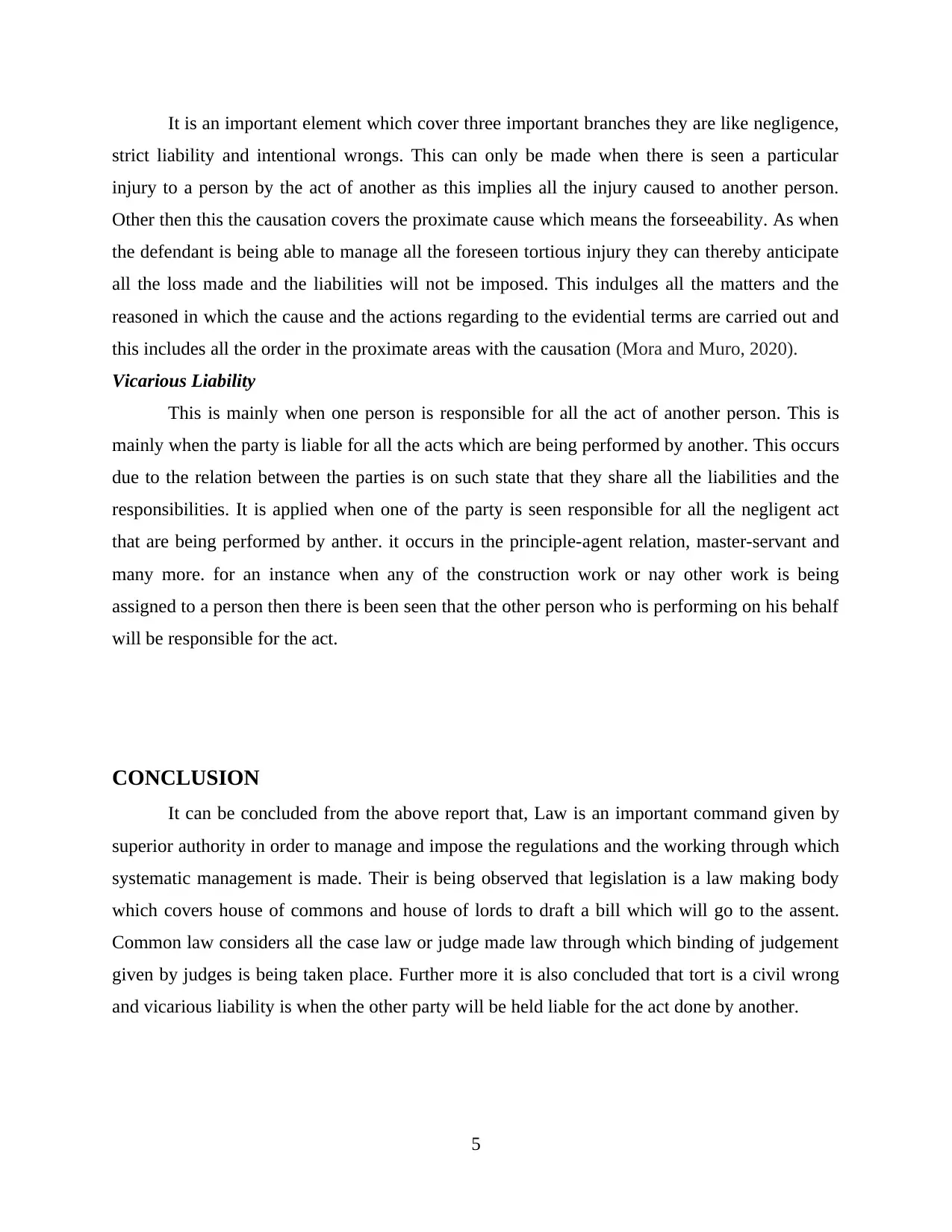
It is an important element which cover three important branches they are like negligence,
strict liability and intentional wrongs. This can only be made when there is seen a particular
injury to a person by the act of another as this implies all the injury caused to another person.
Other then this the causation covers the proximate cause which means the forseeability. As when
the defendant is being able to manage all the foreseen tortious injury they can thereby anticipate
all the loss made and the liabilities will not be imposed. This indulges all the matters and the
reasoned in which the cause and the actions regarding to the evidential terms are carried out and
this includes all the order in the proximate areas with the causation (Mora and Muro, 2020).
Vicarious Liability
This is mainly when one person is responsible for all the act of another person. This is
mainly when the party is liable for all the acts which are being performed by another. This occurs
due to the relation between the parties is on such state that they share all the liabilities and the
responsibilities. It is applied when one of the party is seen responsible for all the negligent act
that are being performed by anther. it occurs in the principle-agent relation, master-servant and
many more. for an instance when any of the construction work or nay other work is being
assigned to a person then there is been seen that the other person who is performing on his behalf
will be responsible for the act.
CONCLUSION
It can be concluded from the above report that, Law is an important command given by
superior authority in order to manage and impose the regulations and the working through which
systematic management is made. Their is being observed that legislation is a law making body
which covers house of commons and house of lords to draft a bill which will go to the assent.
Common law considers all the case law or judge made law through which binding of judgement
given by judges is being taken place. Further more it is also concluded that tort is a civil wrong
and vicarious liability is when the other party will be held liable for the act done by another.
5
strict liability and intentional wrongs. This can only be made when there is seen a particular
injury to a person by the act of another as this implies all the injury caused to another person.
Other then this the causation covers the proximate cause which means the forseeability. As when
the defendant is being able to manage all the foreseen tortious injury they can thereby anticipate
all the loss made and the liabilities will not be imposed. This indulges all the matters and the
reasoned in which the cause and the actions regarding to the evidential terms are carried out and
this includes all the order in the proximate areas with the causation (Mora and Muro, 2020).
Vicarious Liability
This is mainly when one person is responsible for all the act of another person. This is
mainly when the party is liable for all the acts which are being performed by another. This occurs
due to the relation between the parties is on such state that they share all the liabilities and the
responsibilities. It is applied when one of the party is seen responsible for all the negligent act
that are being performed by anther. it occurs in the principle-agent relation, master-servant and
many more. for an instance when any of the construction work or nay other work is being
assigned to a person then there is been seen that the other person who is performing on his behalf
will be responsible for the act.
CONCLUSION
It can be concluded from the above report that, Law is an important command given by
superior authority in order to manage and impose the regulations and the working through which
systematic management is made. Their is being observed that legislation is a law making body
which covers house of commons and house of lords to draft a bill which will go to the assent.
Common law considers all the case law or judge made law through which binding of judgement
given by judges is being taken place. Further more it is also concluded that tort is a civil wrong
and vicarious liability is when the other party will be held liable for the act done by another.
5
Paraphrase This Document
Need a fresh take? Get an instant paraphrase of this document with our AI Paraphraser
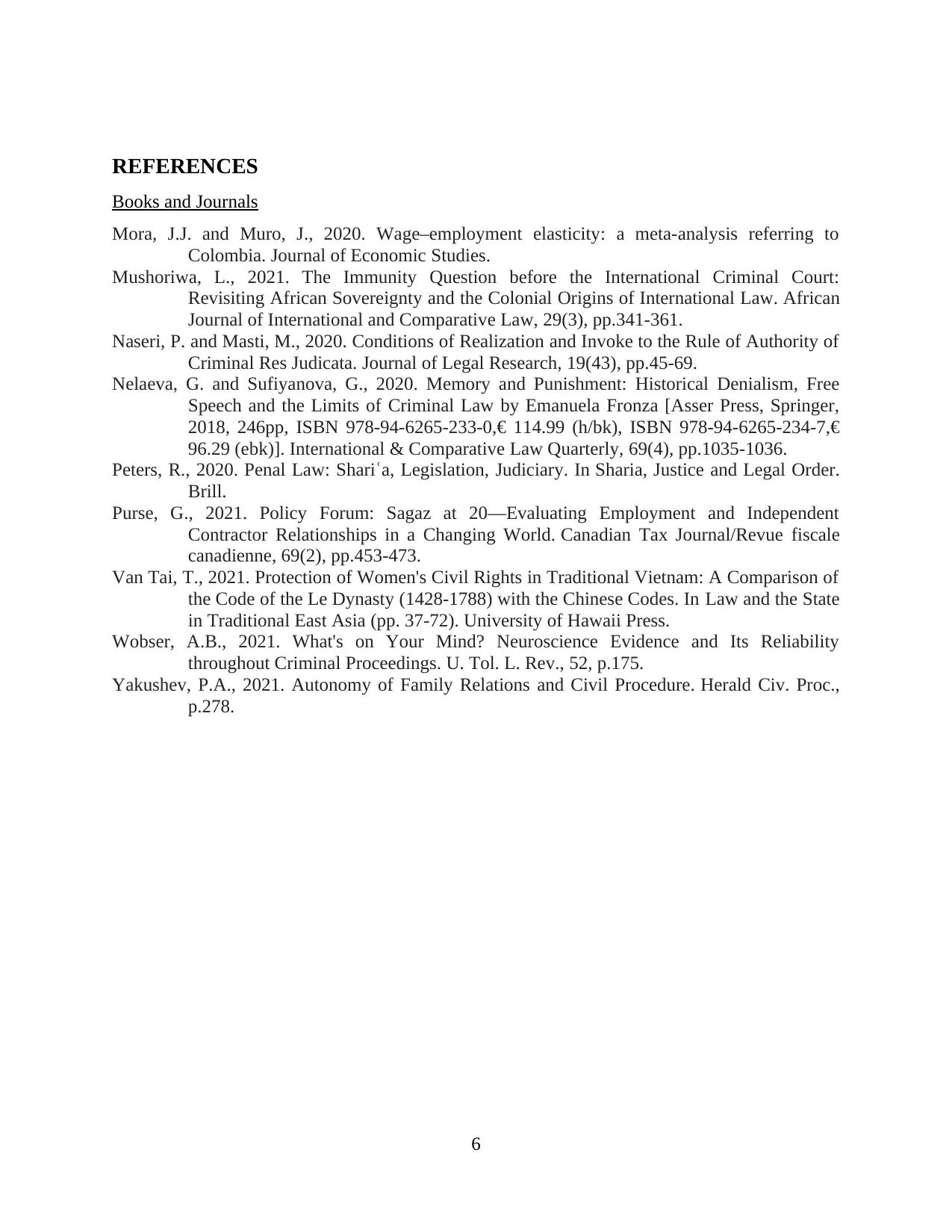
REFERENCES
Books and Journals
Mora, J.J. and Muro, J., 2020. Wage–employment elasticity: a meta-analysis referring to
Colombia. Journal of Economic Studies.
Mushoriwa, L., 2021. The Immunity Question before the International Criminal Court:
Revisiting African Sovereignty and the Colonial Origins of International Law. African
Journal of International and Comparative Law, 29(3), pp.341-361.
Naseri, P. and Masti, M., 2020. Conditions of Realization and Invoke to the Rule of Authority of
Criminal Res Judicata. Journal of Legal Research, 19(43), pp.45-69.
Nelaeva, G. and Sufiyanova, G., 2020. Memory and Punishment: Historical Denialism, Free
Speech and the Limits of Criminal Law by Emanuela Fronza [Asser Press, Springer,
2018, 246pp, ISBN 978-94-6265-233-0,€ 114.99 (h/bk), ISBN 978-94-6265-234-7,€
96.29 (ebk)]. International & Comparative Law Quarterly, 69(4), pp.1035-1036.
Peters, R., 2020. Penal Law: Shariʿa, Legislation, Judiciary. In Sharia, Justice and Legal Order.
Brill.
Purse, G., 2021. Policy Forum: Sagaz at 20—Evaluating Employment and Independent
Contractor Relationships in a Changing World. Canadian Tax Journal/Revue fiscale
canadienne, 69(2), pp.453-473.
Van Tai, T., 2021. Protection of Women's Civil Rights in Traditional Vietnam: A Comparison of
the Code of the Le Dynasty (1428-1788) with the Chinese Codes. In Law and the State
in Traditional East Asia (pp. 37-72). University of Hawaii Press.
Wobser, A.B., 2021. What's on Your Mind? Neuroscience Evidence and Its Reliability
throughout Criminal Proceedings. U. Tol. L. Rev., 52, p.175.
Yakushev, P.A., 2021. Autonomy of Family Relations and Civil Procedure. Herald Civ. Proc.,
p.278.
6
Books and Journals
Mora, J.J. and Muro, J., 2020. Wage–employment elasticity: a meta-analysis referring to
Colombia. Journal of Economic Studies.
Mushoriwa, L., 2021. The Immunity Question before the International Criminal Court:
Revisiting African Sovereignty and the Colonial Origins of International Law. African
Journal of International and Comparative Law, 29(3), pp.341-361.
Naseri, P. and Masti, M., 2020. Conditions of Realization and Invoke to the Rule of Authority of
Criminal Res Judicata. Journal of Legal Research, 19(43), pp.45-69.
Nelaeva, G. and Sufiyanova, G., 2020. Memory and Punishment: Historical Denialism, Free
Speech and the Limits of Criminal Law by Emanuela Fronza [Asser Press, Springer,
2018, 246pp, ISBN 978-94-6265-233-0,€ 114.99 (h/bk), ISBN 978-94-6265-234-7,€
96.29 (ebk)]. International & Comparative Law Quarterly, 69(4), pp.1035-1036.
Peters, R., 2020. Penal Law: Shariʿa, Legislation, Judiciary. In Sharia, Justice and Legal Order.
Brill.
Purse, G., 2021. Policy Forum: Sagaz at 20—Evaluating Employment and Independent
Contractor Relationships in a Changing World. Canadian Tax Journal/Revue fiscale
canadienne, 69(2), pp.453-473.
Van Tai, T., 2021. Protection of Women's Civil Rights in Traditional Vietnam: A Comparison of
the Code of the Le Dynasty (1428-1788) with the Chinese Codes. In Law and the State
in Traditional East Asia (pp. 37-72). University of Hawaii Press.
Wobser, A.B., 2021. What's on Your Mind? Neuroscience Evidence and Its Reliability
throughout Criminal Proceedings. U. Tol. L. Rev., 52, p.175.
Yakushev, P.A., 2021. Autonomy of Family Relations and Civil Procedure. Herald Civ. Proc.,
p.278.
6
1 out of 8
Related Documents
Your All-in-One AI-Powered Toolkit for Academic Success.
+13062052269
info@desklib.com
Available 24*7 on WhatsApp / Email
![[object Object]](/_next/static/media/star-bottom.7253800d.svg)
Unlock your academic potential
© 2024 | Zucol Services PVT LTD | All rights reserved.


